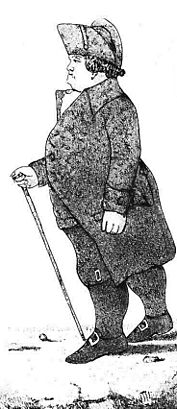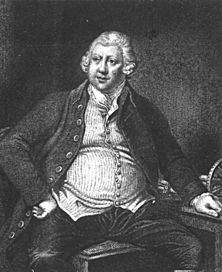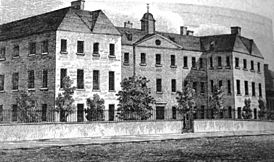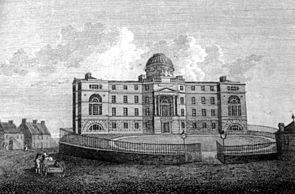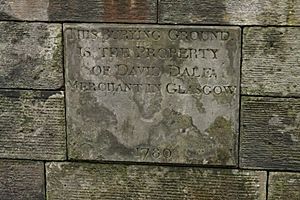David Dale facts for kids
Quick facts for kids
David Dale
|
|
|---|---|
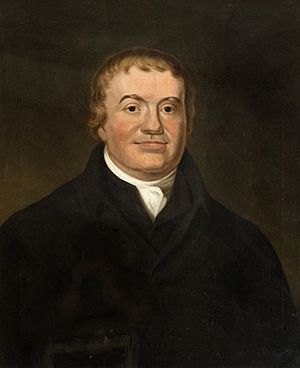
David Dale c. 1800
|
|
| Born | 6 January 1739 |
| Died | 7 March 1806 (aged 67) Rosebank House, Cambuslang, Lanarkshire, Scotland
|
| Burial place | Ramshorn Cemetery, Glasgow |
| Spouse(s) |
Anne Caroline Campbell
(m. 1777, died) |
| Children | 9 |
| Relatives | Robert Owen (son-in-law) |
David Dale (born January 6, 1739 – died March 7, 1806) was an important Scottish businessman and generous helper of others. He lived during a time of great new ideas in Scotland, called the Scottish Enlightenment.
David Dale was very successful in many businesses, especially in making cotton thread. He started the famous cotton mills in New Lanark. Here, he created amazing living and learning conditions for his workers. These conditions were much better than anywhere else in the United Kingdom at that time. People from all over the world came to visit New Lanark.
Robert Owen, who married Dale's daughter Caroline in 1799, used New Lanark to test his ideas. He believed in creating communities where people lived and worked together. He also had new ideas about education and helping people grow. A Scottish historian named Tom Devine called Dale "the greatest cotton boss of his time in Scotland."
Contents
David Dale's Early Life and Work
David Dale was born in Stewarton, Ayrshire, Scotland, on January 6, 1739. His father, William Dale, was a general dealer in the village. His mother was Martha Dunlop. While his birth date is usually given as January 6, church records show he was baptized on January 14, 1739.
As a child, David worked with cattle as a "herd laddie." This was a simple job in a time when many farmers were very poor. His family was not rich, but they were not as poor as some tenant farmers.
David's father arranged for him to learn how to weave cloth by hand in Paisley. Later, David became an agent in Hamilton and then Cambuslang. His job was to give out yarn to weavers and collect the finished cloth. Around 1763, he moved to Glasgow. There, he worked as a clerk for a silk merchant. Soon after, he started his own small business on High Street. He imported linen yarns from France and the Netherlands.
His business grew quickly, and David Dale became a rich merchant in Glasgow. In 1777, when he was 38, he married Anne Caroline Campbell. She was 24 years old. Her father had been a top manager at the Royal Bank of Scotland. In 1783, Dale had his own large house built in Glasgow's fancy Charlotte Street. David and Caroline were married for 14 years until she passed away. They had nine children together, but four of them, including their only son, died when they were babies.
Growing His Business
Between 1783 and 1785, David Dale's career really took off. By 1785, he was no longer just a city merchant. He was becoming a successful entrepreneur, a banker, and a factory owner.
In 1783, he joined Robert Scott Moncrieff, a businessman from Edinburgh. They set up the first Glasgow office of the Royal Bank of Scotland. His wife's family connections might have helped with this business deal. Within a few years, the Glasgow branch was handling a lot of money.
At this time, America was no longer a British colony. Glasgow merchants no longer relied on tobacco for their wealth. Textiles (cloth), sugar, and rum became the new big businesses. In 1783, Dale also helped start the Glasgow Chamber of Commerce. This was the first business group of its kind in Britain. Dale became a director and later a deputy chairman. He worked with many important people in Glasgow. These included former "Tobacco Lords" and merchants from sugar, rum, textile, coal, chemical, and brewing industries. Dale became a very important person in Glasgow's business world. He remained influential until he died.
People said that Dale had become a very successful Glasgow merchant. They said he had broken through the social barriers that once separated him from the rich tobacco and sugar lords. He could now proudly take his place among the most important people in the city.
New Lanark Mills
In 1784, Richard Arkwright visited Scotland. He was asked to come by George Dempster of Dunnichen, a landowner and Member of Parliament. Arkwright owned several successful cotton mills in England. He was known as the "father of the cotton industry" and was one of the richest men in Britain. He was convinced to visit Lanark to consider building a cotton mill there.
David Dale and George Dempster went with Arkwright to the place where New Lanark is today. They thought the spot was perfect. It had a powerful waterfall on the River Clyde that could power the machinery. The three men agreed to become business partners.
Building work started right away. The mill buildings were designed like Arkwright's own mills in Cromford, England. Men and boys from New Lanark were sent to Cromford for training. The mills began spinning cotton in early 1786. At this point, both Dempster and Arkwright left the partnership. This left David Dale as the only owner. By the 1790s, almost 1,400 people were living and working in the New Lanark community.
Business was booming, and the village attracted thousands of visitors from all over the world. Famous visitors included William Wordsworth, Dorothy Wordsworth, Samuel Taylor Coleridge, and Robert Owen. They were interested in the very successful cotton spinning business. But New Lanark also became known as a special factory community. It was a place where business, helping others, and education all came together for the first time in Britain. The community became as famous for its social care and education as it did for its mills. This was something Robert Owen would later build upon.
Children in the Mills
A lot of attention was given to how David Dale treated the children who worked for him. These were often called apprentice or pauper children. It was common for many children to work in mills and other places. They usually started working around age 6 or 7 and continued until about age 15.
In New Lanark, children from the village worked alongside about 300 apprentice children. These children came from charity workhouses in Glasgow and Edinburgh. They were often orphans, cared for by the local church or government. These groups were very keen to save money by sending the children out to work.
The children were not paid wages. Instead, they received a place to live and food in No. 4 Mill. At first, they worked at simple jobs like reeling and picking cotton. Later, they learned many different skills that they could use when they left the mills. Some joined the army or navy. Some became carpenters or blacksmiths. Others stayed on to work in New Lanark. Employers like Dale were seen as kind and helpful. They offered children a chance to work, a place to live, and the opportunity to learn useful skills.
The children worked from 6 AM until 7 PM. They had breaks for breakfast and dinner. They were given two sets of work clothes, which were washed regularly. They also had a blue dress uniform for Sundays. Their sleeping areas were cleaned often. There is evidence that many of the apprentice children had better living conditions than some of the local children.
Dr. James Currie, a public health campaigner, was one of the many visitors to New Lanark. He wrote that: "The whole factory was very clean, healthy, and orderly. The children looked happy and cheerful with rosy cheeks. I found many excellent rules for health, good behavior, and learning."
Like Robert Owen later, David Dale believed that a good education was important for everyone. This was a new idea for factory communities. In England, some factory owners like Arkwright offered Sunday schools. But in New Lanark, there was a day school every day for children under six. There was also an evening school from 7-9 PM for older children.
The school had a set plan of what to teach. This included reading, writing, and arithmetic (the "3Rs"). They also learned sewing, church music, and religious studies. At one point, over 500 students were enrolled in the school. Dale employed 16 trained teachers to teach more than eight classes. Students were grouped by their ability. They moved to the next class after passing tests. Teachers received a bonus for each student who moved up.
All the information we have shows that Dale provided much better conditions than were available anywhere else in Britain at that time. Dale himself explained why he thought employing the children was good: "...when you think that most of the children in the boarding house are orphans, or children abandoned by their parents... it makes me very happy to say that with good care, much good instead of harm can be done at cotton mills. I can truly say that many now have strong, healthy bodies and good manners. They probably would have been sick and a problem to society if they had not worked at the Lanark cotton mills."
Robert Owen visited New Lanark many times. In 1799, he married Dale's daughter, Caroline. Owen and his business partners bought New Lanark. Owen became the sole manager on January 1, 1800. Over the next twenty years, Owen became famous for improving the social conditions of his workers. Some of his improvements were based on practices that Dale had already started. Some historians say that Owen made the problems at New Lanark seem worse than they were. He did this to make his own improvements seem more important. However, they also agree that both men achieved great things.
Other Businesses and Helping Others
David Dale's business interests continued to grow. He had a house in New Lanark, but William Kelly, a skilled engineer, managed the daily operations. The main offices for his business were in St Andrew's Square, Glasgow. Dale continued to live in Charlotte Street in the city. Later in life, he bought a country house called Rosebank in Cambuslang. He divided his time between New Lanark, the Royal Bank, and his Glasgow offices.
He was involved in several other cotton mills. Soon after starting New Lanark, Dale built a new mill in Blantyre. He also built a school for the apprentices there. He sold this business in 1792. In 1788, Dale partnered with Claud Alexander to open a spinning mill in Catrine in Ayrshire. Dale was very involved in designing these mills. Within a few years, about 1,300 people worked there. Again, there were apprentice children (but not pauper children) and a proper school was provided. He stayed involved with this business until 1801 when the mills were sold.
In partnership with others, he opened a small mill in Spinningdale in Sutherland. This was more about helping people than making money. The goal was to provide work and help people during famine and hardship in the area. It also aimed to stop people from leaving the Highlands. Dale stayed involved long after others had left. He continued to pay for it until two years before he died. The mill burned down a year later.
In Glasgow, Dale's business profile continued to grow. In Dalmarnock, he set up a dyeworks. Here, cloth was dyed with a new, colorfast dye called 'Turkey Red'. It was sometimes known in the city as 'Dale’s Red'. In the city center, where Ingram Street is now, he built a warehouse and a small factory. This factory made linen strips or tapes known as 'incles' or Scotch Tape. The company was called Dale, Campbell, Reid & Dale. The second Dale was his nephew, David Dale Junior.
Still in Glasgow, Dale invested in the insurance business. He became a director of the Glasgow Fire Insurance Company. This company sold life insurance and annuities. Dale also owned a lot of property in and around the city. This included land and buildings in areas like Ramshorn (Ingram Street), Shuttle Street, Barrowfield, Ruchill, and Parkhead.
Helping His Community
David Dale was also a director or manager of many charity projects throughout Glasgow. Newspapers at the time often wrote about his kindness, generosity, and good deeds. Much of this came from his strong religious beliefs. He was a deeply religious Christian and a pastor in the Dissenting (Secessionist) Church. He preached on Sundays in meeting houses all over the city. He once said in a sermon: "Riches are one great goal. These often fly away... they do not help on the day of judgment. And if these are gained by hurting the poor, or not giving to the needy what they need from us, the result is terrible... your riches are ruined."
He regularly gave money to small charities. These included a fund for prison reform, a charity for injured soldiers, and the Royal Northern Infirmary in Inverness. He also supported Perth Academy and the newly formed Glasgow Humane Society. He agreed to become a director and help raise money for them.
He was even more known for his public charity and civic duties. He served as a Bailie and Magistrate in the city for two years. He found this job very time-consuming and difficult. Yet, he gained a reputation in the press for being fair and kind. He became known as 'The Benevolent Magistrate'.
When a new road was needed between Clydesdale and England, he gave £700 towards the cost. On several occasions, he helped feed those in need. For example, he provided food to the poor in Stewarton at a very low price. He also sent a ship to the U.S. to bring back grain, which he then gave to the poor in Glasgow.
For twenty years, he was a director of the Town’s Hospital. This was like a charity workhouse for the poor, orphans, elderly, sick, and, until 1814, people with mental illness. He served on the institution’s Manufacturing Committee.
Dale was also involved with the Glasgow Royal Infirmary. This hospital was for "poor people suffering from illness in the west of Scotland." Dale was part of this project from its very start in 1788. He led the group that raised money, found the land, and oversaw the building of this major city hospital. He gave £200 himself. When the building finally opened in 1795, he was appointed as a manager. He spent the rest of his life as a manager or director. He did not gain anything personally from this commitment. The Infirmary was for the poor. However, as a manager, he had the right to send some of his workers from New Lanark there. Between 1795 and 1803, he personally sent about 64 patients.
David Dale and Slavery
The raw cotton used in Dale's cotton mills came from places like the United States, South America, and the West Indies. In those regions, this cotton was often produced using slave labor.
However, by the late 1700s, people's opinions about slavery were starting to change. The new British movement to end slavery was growing quickly. This movement in Britain was led by Thomas Clarkson and William Wilberforce. They oversaw the actions of the London Society, which sent people across the country to get support for anti-slavery petitions.
The Glasgow Society for the Abolition of the Slave Trade was set up in January 1791. David Dale became its chairman. In the same year, he bought shares in the newly formed Sierra Leone Company. This company aimed to create a colony of freed slaves in West Africa.
The Glasgow group helped spread the London Society's pamphlet. They added a special introduction about their new Glasgow Society. There were several meetings throughout 1791, all led by Dale. The Society sent money to the London campaign offices. The next year, it met many times to support public petitions. These petitions were being created in all the cities and towns in Scotland.
At a meeting of the Glasgow Society on February 1, 1792, with Dale as chairman, the members decided: "...that the trade in human beings is based on the greatest unfairness. It involves extreme cruelty and harshness to innocent people. It also causes ruin and destruction in a country that could be helped by the efforts of Great Britain's well-directed industry."
About business and the Enlightenment, they said: "[the slave trade]... goes directly against the main laws of nature... and that its continuation, in this time of new ideas, is shameful for the nation and completely against what Christians believe."
Death
When David Dale died at his home, Rosebank House in Cambuslang, Lanarkshire, on March 7, 1806, huge crowds of mourners lined the streets of Glasgow. He was buried in the Ramshorn Cemetery in central Glasgow. He had bought the grave plot some years before. It is located on the outer east wall towards the north-east corner.
The Glasgow Herald newspaper's obituary (a notice about his death) recognized his achievements as a businessman. It also noted that: "...he always listened to people in distress; his private acts of charity were endless; and every public organization that aimed to reduce or prevent human suffering, in this world or the next, received his most generous support and encouragement."
Images for kids


